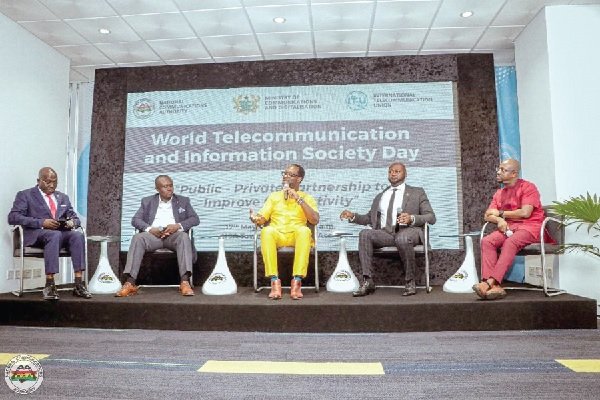The lack of connectivity infrastructure in some areas is a major obstacle preventing Mobile Network Operators (MNOs) from being competitive in Ghana’s telecoms market, the Chief Executive Officer of MTN, Selorm Adadevor, has said.
Sharing valuable insights into connectivity in the country, he, however acknowledged what he described as the significant growth in connectivity through both inland and undersea infrastructure.
Consequently, Mr Adadevor said MTN Ghana, for instance, has partnered the government, particularly the Ministry of Communications and Digitalisation, to bridge the digital divide and provide access to essential communication services to all.
The MTN CEO was sharing his thoughts as he joined other panellists at a forum organised by the National Communications Authority (NCA) to call for increased collaboration between the public and private sectors to improve communication connectivity in Ghana.
The panel discussion held as part of the World Telecommunications and Information Society Day (WTISD-23) celebration, which was commemorated globally on May 17th, 2023, was on the theme: “Public-Private Partnership to Improve Connectivity” and brought together key stakeholders to explore collaborative efforts to enhance connectivity.
The other panellists included the Administrator of the Ghana Investment Fund for Electronic Communications (GIFEC), Prince Ofosu Sefah, Country Manager for MainOne, Emmanuel Kwarteng, and a representative from the National Information Technology Agency (NITA), Solomon Richardson.
Commitments
Mr Adadevor said as part of MTN’s collaboration with the sector ministry, the telecom giant had committed to investing $25 million in an ICT hub.
This investment, which has been discussed with the sector Minister, Ursula Owusu-Ekuful, aims to provide digital skills education, particularly for youth and girls and enhance ICT literacy.
Mr Adadevoh also highlighted MTN Ghana’s collaboration with GIFEC in the Ghana Rural Telephony and Digital Inclusion Project (GRT&DIP).
Through this project, he said MTN was involved in building 2016 rural sites to improve telephony and digital access in rural areas.
Connectivity
Mr Ofosu Sefah, for his part, discussed the Fund’s primary programmes focused on rural connectivity, cyber labs, and ICT capacity-building.
These programmes, he said, served as the foundation for achieving meaningful connectivity.
He said GIFEC’s commitment was to ensure that underserved and unserved communities had access to connectivity.
Mr Ofosu Sefah also reiterated the challenges they faced in providing devices to facilitate access and connectivity stressing that this underscored the importance of capacity-building initiatives to empower users in utilising these devices and making the most of the available access.
Further, he expressed GIFEC’s intention to collaborate with investors in line with their vision of expanding connectivity to unserved and underserved communities adding that GIFEC recognised the necessity of making infrastructure available to accomplish this goal.
Infrastructure
Mr Richardson, the Director for Technical Services at NITA, underscored NITA’s focus on providing the necessary infrastructure to connect all government institutions in supporting the government’s digital agenda.
He mentioned the e-government connectivity project which ensured that every district had a minimum capacity of one Gigabyte (1GB).
Additionally, he hinted that NITA was establishing last-mile connectivity within districts where infrastructure was available, enabling health facilities, police stations, and other government agencies to connect with the district population.
He also said the government, in collaboration with GIFEC, Kofi Annan Centre of Excellence in ICT, NITA, and partner agencies had initiated various programmes to equip the public with essential skills for utilising these technologies.
Fibre cuts
Mr Emmanuel Kwarteng from MainOne said the challenge of fibre cuts remained significant in the industry.
MainOne, for instance, spends at least $6 million dollars to repair the fibre whenever there is a cut. To address this issue, he said, the company had implemented an Automatic Identification System (AIS) to monitor the country’s shores, covering approximately 120 kilometers.
The terrestrial aspect, on the other hand, involves multiple licensed players engaged in metro operations whose costs increase due to frequent fibre cuts.
Mr Kwarteng also said MainOne had been proactively collaborating with industry regulators to educate road contractors and engineers, ensuring that they were aware of the importance of protecting fibre infrastructure.
www.graphic.com.gh


